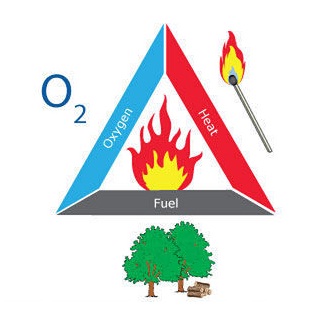Can forest fires ignite on their own or does it have to be an actor?!
Weather of Arabia - Scientists have classified the reasons behind forest fire disasters that erupt from time to time in many countries as being caused by natural and other human-caused causes, and the worsening global fire crisis may be linked to global warming, along with record-breaking droughts in certain regions, which Make bushfire season more active than ever. But how do fires start? Can it ignite on its own or does an actor have to be present?
Let's first begin by understanding: what is fire and how does it occur?
Fire is defined as a chemical phenomenon that occurs as a result of the union of a burning substance with oxygen in the air, under the influence of a certain temperature called the ignition point, which is the temperature at which that substance reached, it began to ignite. There are three elements necessary for ignition, or the so-called fire triangle, which are:
1. Fuel or combustible materials: It exists in 3 cases:
- Solid, such as: wood, paper, cloth.
- Liquid and semi-liquid, such as: greases of all kinds, oils, gasoline, alcohol.
- Gaseous gases, such as: butane, acetylene, methane.
2. Oxygen: It is available in the air. The air contains 21% oxygen gas.
3. Heat: that is, the temperature of the substance reaching the degree necessary for ignition. The source of heat can be: sparks, flames, friction, sunlight, chemical reactions, etc.
The ignition is extinguished by breaking one of the sides of the fire triangle, that is, by one of the following methods:
- Stop the flow of fuel: or limit it by splitting the combustible materials and removing the unburned ones.
- Preventing oxygen from flowing: It is done by asphyxiation, which means preventing oxygen from uniting with the other two elements.
- Separation of the heat source: It is done by cooling i.e. reducing the temperature below a certain ignition point.

Causes of forest fires
Forest fires occur when the three elements of fire combine. In forests, fuel (plants) and oxygen are available, and the third element (heat) can be provided by human action by causing a spark or igniting a flame, or by natural causes.
1. Human Causes: In the 22,000-acre California wildfires in 2020, a couple were accused of being the cause after having a party near the woods, and fires were also reported when villagers started small fires to keep animals away. Wild predatory for goats and poultry in the village.
2. Natural causes: Natural causes are the main factor for forest fires. Human-caused fires are usually detected early and are therefore relatively easily contained compared to natural fires that may burn for several days in bushes before they are detected.
Here are some of the natural causes of forest fires:
Lightning spark: Natural fires are generally started by lightning, where a very small percentage of spontaneous combustion of dry fuels such as sawdust and leaves begins, and the fire expands with the presence of weather factors such as heat, dryness and wind.
Friction: Often, wildfires are caused by natural causes when trees and other plants dry out. Trees rub together at high wind speeds, and the heat of the friction causes a fire to catch on. And due to the high temperatures during the summer, not only the trees, but also the grasses, leaves and other plants that cover the ground dry up completely, the absence of the usual dense foliage causes the winds to blow faster and quickly transfer the fire to other parts of the forest.
Sunlight: The heat of the sun heats and dries trees and plants. When wood is heated to ignition, it burns. As temperatures rise, the "potential fuel" ignites and burns faster, increasing the rate of wildfires. For this reason, wildfires tend to occur and flare up in the afternoon, when temperatures are at their highest.
Spontaneous combustion or spontaneous ignition occurs by spontaneous heating and increasing temperature due to internal exothermic reactions such as bacterial fermentation.
Haystacks may spontaneously ignite due to heat from bacterial fermentation within two to six weeks of storage, as dangerous heating occurs in straw with moisture greater than 25%. The process begins with microbiological activity (bacteria or mold), and at 100°C, wet hay absorbs twice as much oxygen as dry straw. Which makes it easy to ignite.
Arabia Weather App
Download the app to receive weather notifications and more..



